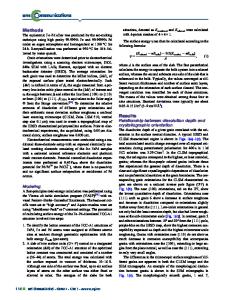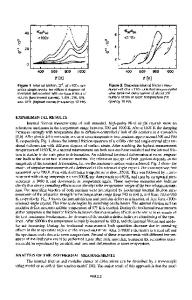UFG to NC FePd by Combined Reaction Transformation Mode of Severely Plastically Deformed Disordered FePd
- PDF / 3,626,947 Bytes
- 6 Pages / 612 x 792 pts (letter) Page_size
- 6 Downloads / 339 Views
0980-II05-18
UFG to NC FePd by Combined Reaction Transformation Mode of Severely Plastically Deformed Disordered FePd Vincent Sokalski, Andreas Kulovits, and Jorg Wiezorek Dept. of Mechanical Engineering and Materials Science, University of Pittsburgh, 848 Benedum Hall, Pittsburgh, PA, 15261 ABSTRACT Numerous studies have shown that equiaxed ultra fine grained FePd alloys can be produced by phase transformation of heavily deformed austenitic FePd via the combined reaction mode. As the magnetic properties can be improved by suppressing development of the polytwinned microconstituent formed by the conventional ordering mode, it appears reasonable to speculate that further grain refinement might lead to further property enhancement. In order to reduce the grain size in bulk intermetallic alloys severely plastically deformed austenitic FePd has been phase transformed in this study. Equal channel angular pressing (ECAP) has been used to deform disordered FePd. The microstructure and property evolution during the deformation process and post-deformation annealing have been studied using transmission electron microscopy (TEM) and hardness and magnetization curve measurements. The observations are compared to known results from use of other deformation processing routes, such as cold rolling. INTRODUCTION It is well established that upon heat treatment of cold-deformed disordered FCC FePd two different phase transformation modes compete with each other [1]. One mode is conventional ordering, where during the recovery processes, i.e. while excess point defects annihilate and dislocation rearrangements occur, very small L10 ordered nuclei are formed in the strain fields of the line defects present in the heavily deformed FCC matrix. In a global picture it appears as if the long range order continuously increases in the deformed disordered material and most of the cold deformation induced defect structure is retained. Recrystallization in those regions is very sluggish, as each of the ordered nuclei is a pinning point to any mobile transformation interface. The second mode is the combined reaction [1,2]. New ordered grains nucleate coherently on prior existing grain boundaries and grow incoherently into the deformed FCC matrix, quite similar to discontinuous massive transformations [1,2]. The defect content from the cold-deformation is lowered considerably and new ordered material is produced at the same time, i.e. recrystallization and the phase transformation occur simultaneously. Hence, this mode is referred to as combined reaction (CR) transformation [2]. The newly CR transformed grains are initially defect free. During grain growth defects develop, which often are associated with dynamics at the mobile transformation interfaces [3]. In contrast to the conventional ordering transformation, where the driving force stems in first approximation entirely from the disorder/order reaction, the driving force for the CR mode is a combination of the free energy release due to lowering of the stored strain energy from cold-deformat
Data Loading...











